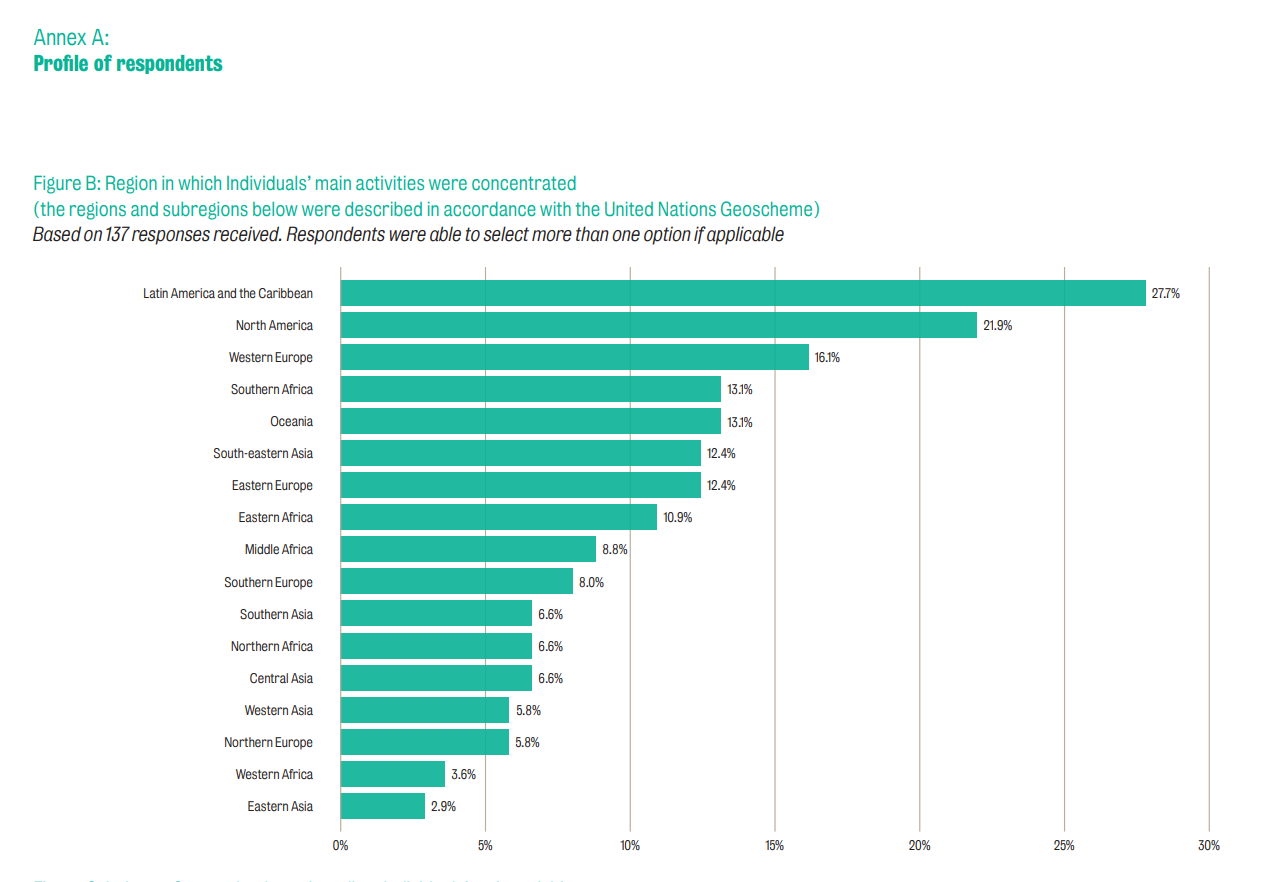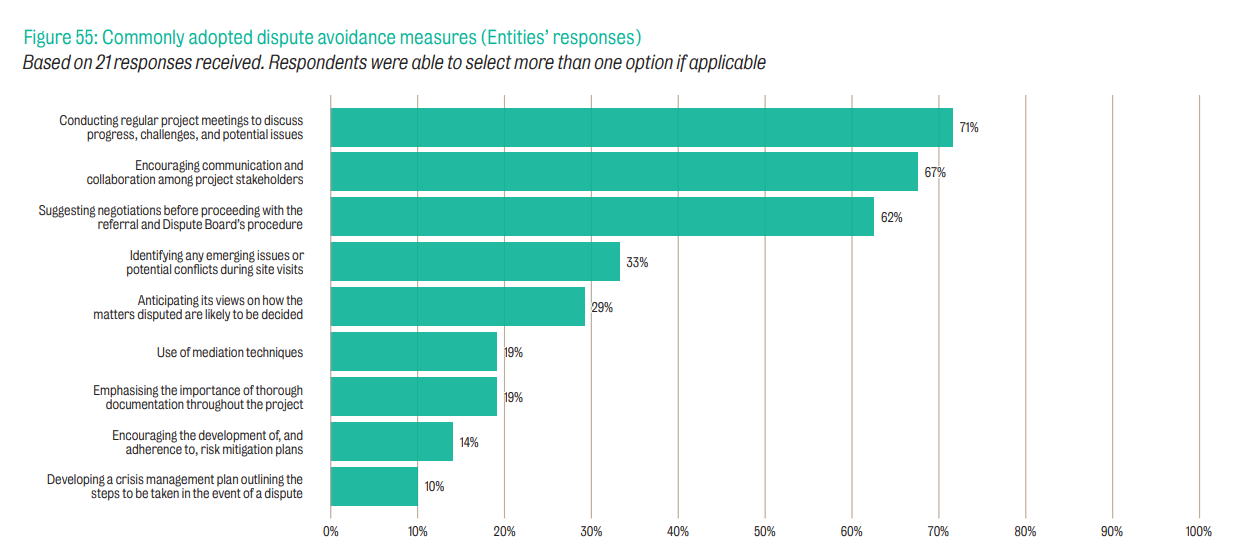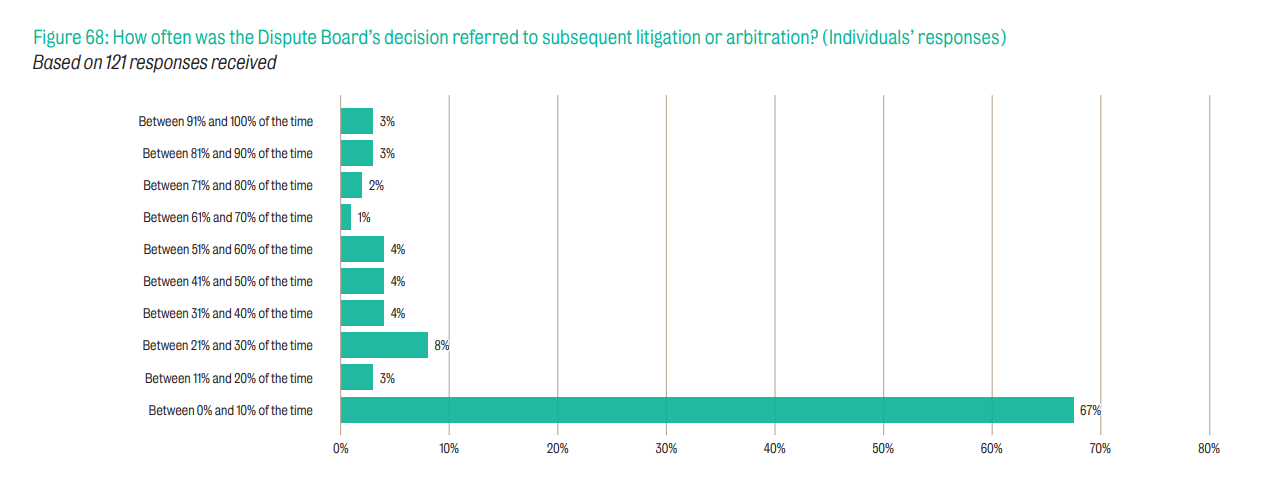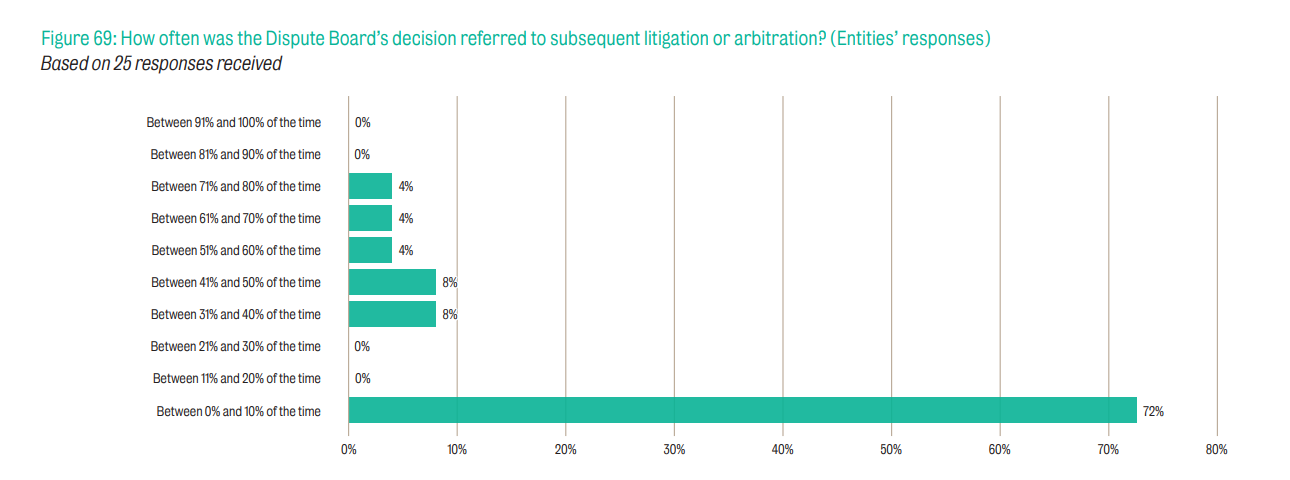Dispute Boards: Do they work?
By Claire King
On 9 December 2024 I had the pleasure of attending the launch event of King’s College London’s report “2024 Dispute Boards International Survey: A Study on the Worldwide Use of Dispute Boards over the Past Six Years” (the “Report”).1 Written by Professor Renato Nazzini2 and Raquel Macedo Moreira, Sir Vivian Ramsey notes that the report allows “reliable data to be collected on all the topics [on Dispute Boards] on which there was until now, with a few exceptions, only anecdotal evidence”.3 Fenwick Elliott partners Professor Nicholas Gould and Jeremy Glover both helped develop the questionnaires sitting behind the data as well as advising on the final report.
The key questions frequently asked about Dispute Boards is the extent to which they work and whether they are worth the cost associated with them (whether standing Dispute Boards or ad hoc). In this Insight we review the findings of the Report and crucially, whether the data suggests Dispute Boards actually work in preventing disputes and/or preventing disputes escalating. If they do, to what extent are they cost effective?
What is a Dispute Board?
Dispute Boards are designed to provide an independent way to avoid, manage and ideally resolve disputes in construction projects. Dispute Boards have steadily gained in popularity, particularly outside of the US, since the early 1980s.4 As their popularity has increased, they have been included in key standard form contracts used internationally. FIDIC was an early pioneer, gradually including Dispute Boards in new editions from 1995 onwards.
Further, since 2017 FIDIC’s Rainbow Suite has broadened the role of the Dispute Board to focus on the early resolution and avoidance of disputes by allowing the Board to proactively try and resolve issues before they become subject to any formal proceedings. Similarly, the ICC5 and other popular international dispute resolution centres provide rules and guidance for Dispute Boards. Domestically here in the United Kingdom the NEC and the JCT have also included Dispute Board options, albeit their popularity is arguably limited due to the right to adjudicate at any time for most construction projects.
Given their variation worldwide, Dispute Boards are defined broadly by the Report, which defines a dispute board as a “job site dispute avoidance or resolution mechanism, constituted by individual(s) that should operate independently from the parties to the contract(s) and with the purpose of addressing the disputes of a specific Project”. “Project” is also defined widely as any “planned endeavour involving the systematic organisation and coordination of resources, labour, materials, and/or tasks to create, renovate, and/or enhance physical or non-physical structures. These structures may include physical constructions such as buildings or infrastructure, as well as intangible constructs such as software systems, digital platforms, or information technology solutions”.
Where did the data come from?
The data sitting behind the report was collected via questionnaires from Individuals6, Entities7, Institutions8 and Funders9. In total there were 213 responses – 156 from Individuals, 34 from Entities, 18 from Institutions and 5 from Funders.10
These covered some 3,323 projects (albeit the possibility of duplication within these is acknowledged) 50.9% of which included Dispute Boards and 4,019 Dispute Boards. Geographically they were also fairly widespread unlike most previous studies which have been limited to particular global regions. The graphic below taken from the Report illustrates this:

The claim values that the data relates to was also significant. The most frequent value of the claims reported by Individuals was between US$2 million and US$5 million (27% of claims) but 15% related to disputes valued at over US$50,000,000. Entities reported the greatest value of claims at between US$5 million and US$10 million and US$1 million to US$2 million but again over 8% of cases were valued at over US$50 million.
The amount of data sitting behind the Report – both in its worldwide scope and the values of claims being dealt with by those answering the questionnaires – is important because it gives a comprehensive snapshot of how useful Dispute Boards are which is not solely dependent on anecdotes from those at conferences with an interest in promoting Dispute Boards. For this reason, and as noted by Sir Vivian Ramsey, “I am sure this report will now become the most cited source of data by all those involved in dispute boards whenever the subject is discussed”.
So how effective are Dispute Boards at resolving disputes?
Dispute Avoidance
As part of answering this question, the Report asked which, if any, dispute avoidance measures were commonly adopted by Dispute Boards acknowledging that, over recent years in particular, the role of the Dispute Board has not only been to reach a decision but also to offer guidance or a way to resolve an issue before it becomes a dispute.
Interestingly, the use of dispute avoidance measures appears to be similar when looked at in the round.11 However, Entities had a higher percentage of responses reporting they occasionally or very rarely used dispute avoidance measures.12 As to what the parties meant by “dispute avoidance” these ranged from the simple decision to hold regular project meeting to discuss progress, challenges and potential issues through to the (less frequently used) technique of developing a crisis management plan outlining the steps to be taken in the event of a dispute. The statistics on the frequency of use of each technique were broadly the same between Individuals and Entities with the frequency for the techniques used for Entities shown below:

As to the effectiveness of Dispute Boards, Individuals noted a particularly high success rate for a dispute being completed avoided. Indeed in 45% of cases Individuals reported that dispute avoidance resulted in a dispute being completely avoided.13 The success rate was lower for Entities but still reporting a relatively high success rate. The two tables are shown side by side below for ease of comparison:


Compliance?
As to the decisions reached by Dispute Boards, it is apparent that even where the decisions were “non-binding” the parties stuck with the recommendation a lot of the time. 26% of the parties stuck with non-binding decisions all of time (and 40% most of the time) based on Individual responses,14 and 30% stuck with them always based on Entities’ responses and 13% “most of the time” based on Entities’ responses.
In relation to compliance with binding decisions the statistics were a little higher with 32% of Individuals saying they would always comply and 32% complying “most of the time” in the Individual responses. Entities reported 35% complying “most of the time” and Individuals reported 17% complying “most of the time”. Perhaps reflecting the flip side of these results, Individuals reported that Notices of Dissatisfaction (“NOD”) were never served in 30% of cases with Entities reporting they were not served in 28% of cases.
Interestingly there is clearly a trend to have Dispute Boards as a mandatory step before commencing proceedings, with 51% of Individuals reporting this was always the case and 42% of Entities reporting this was always the case.
So the initial results are promising. However, the statistics for whether there were then subsequent proceedings referring the Dispute Board’s decision for final determination are stark as shown by the two graphs below:


These are impressive statistics potentially suggesting that even if parties take the step of issuing a NOD they rarely take matters further. Similarly, the vast majority of both Entities’ and Individuals responding to the survey had never been involved in enforcement proceedings of a Dispute Board decision.15
So, in terms of effectiveness of Dispute Boards, the statistics certainly give them a healthy thumbs up.
But are Dispute Boards cost effective?
The next question though is whether the cost is worth the results. The Report’s Executive Summary neatly summarises the position with monthly retainer fees being the most common way of paying for a Dispute Board. This was said to cost, most commonly, less than US$25,000 per year. In terms of overall costs Individuals reported Dispute Boards costing between US$100,001 to US$200,000 whilst Entities reported slightly higher costs at between US$200,001 and US$300,000. It should be noted that these were noted as being in the region of 0% to 0.5% of the project cost (underlining their scale). So Dispute Boards are not necessarily cheap but appear to be good value for money given the scale of the projects where they are used.
Satisfaction levels in relation to costs also appear to be good. 31.6% of Individuals were very satisfied with the costs and 50.4% were satisfied most of the time.16 For Entities, 16% were very satisfied, 32% satisfied and 40% neither satisfied nor dissatisfied. Funders were arguably less content with the costs of Dispute Boards. Whilst 75% of Funders found Dispute Boards “very useful” only 25% were “satisfied” with the costs and 25% were “dissatisfied”.17
The overall picture
In my view, the Report provides good evidence that certainly for large projects Dispute Boards are a cost effective method of both heading off disputes and also preventing them from escalating to all out arbitration or litigation. As such, the trend for including them in not only FIDIC but also other contract forms competing on the world stage (such as NEC) should be encouraged.
For me, one of the interesting discussion points that arose during the launch of this report at King’s College was whether big infrastructure projects here in the United Kingdom that are subject to statutory adjudication could benefit from Dispute Boards. In particular, their apparent potential to use alternative techniques to avoid disputes occurring in the first place and/or to at least reduce the need to go to Court or arbitral proceedings with the cost, time and relationship damage those can bring. One of the downsides of statutory adjudication is that it can lead to entrenched positions without the benefit of an independent eye to tell the parties to step back and find a sensible way through. That is something a Dispute Board can bring to the table where they are incorporated into project’s infrastructure.
- 1. To download a copy of the Report, see: kcl-dpsl-2024-dispute-boards-international-survey-report-digital-aw.pdf
- 2. Recently appointed an Honorary KC.
- 3. See Sir Vivian Ramsey’s Foreword at page 8 of the Report.
- 4. See page 10 of the Report which references the World Bank funding a Dispute Board for the El Cajon hydroelectric power project in Honduras in 1980 as a key project in kick-starting the international popularity of Dispute Boards.
- 5. Dispute Boards - ICC - International Chamber of Commerce
- 6. Defined as “physical persons whose practice involves Dispute Boards”.
- 7. Defined as “commercial or financial entities…whose activities involves Dispute Boards”.
- 8. Defined as “institutions, or their respective nominating bodies, which have (or could have) been requested to intervene in the constitution or functioning of a Dispute Board”.
- 9. Defined as “persons or organisation that funded or financed a Project for which a Dispute Board was considered or adopted”.
- 10. See page 13 of the Report.
- 11. 85% of Individuals reported the adoption of dispute avoidance compared with 84% of Entities.
- 12. 20% of Individuals reported they occasionally used dispute avoidance measures and 14% very rarely compared to 24% of Entities using dispute avoidance measures occasionally and 28% very rarely.
- 13. Based on 111 responses.
- 14. 117 responses were reported as received.
- 15. 8% of Entities had never been involved in enforcing a Dispute Board decision and 9% of Individuals had never been involved.
- 16. See Figure 102 on page 72 of the Report
- 17. See Figure 154 on Page 103 of the Report.
Subscribe to our newsletters
If you would like to receive a digital version of our newsletters please complete the subscription form.
